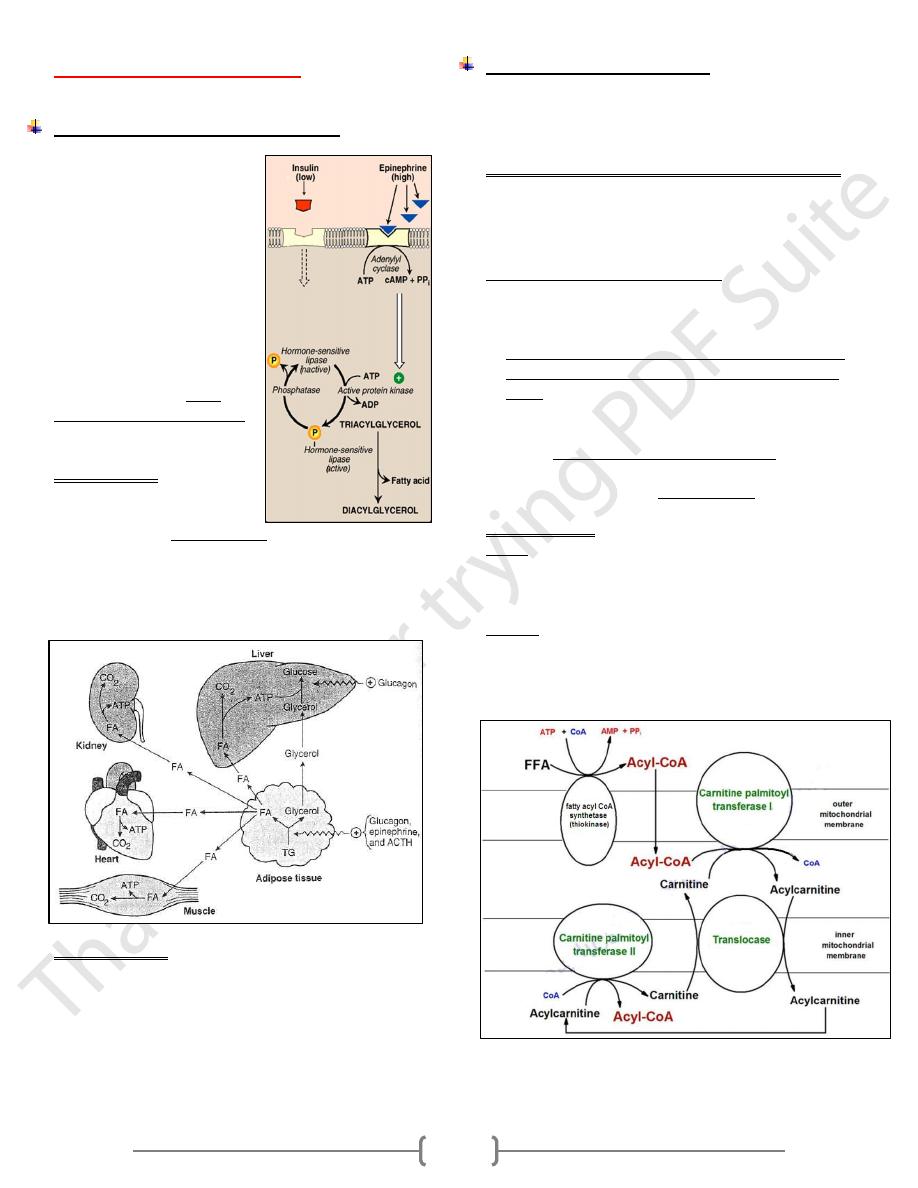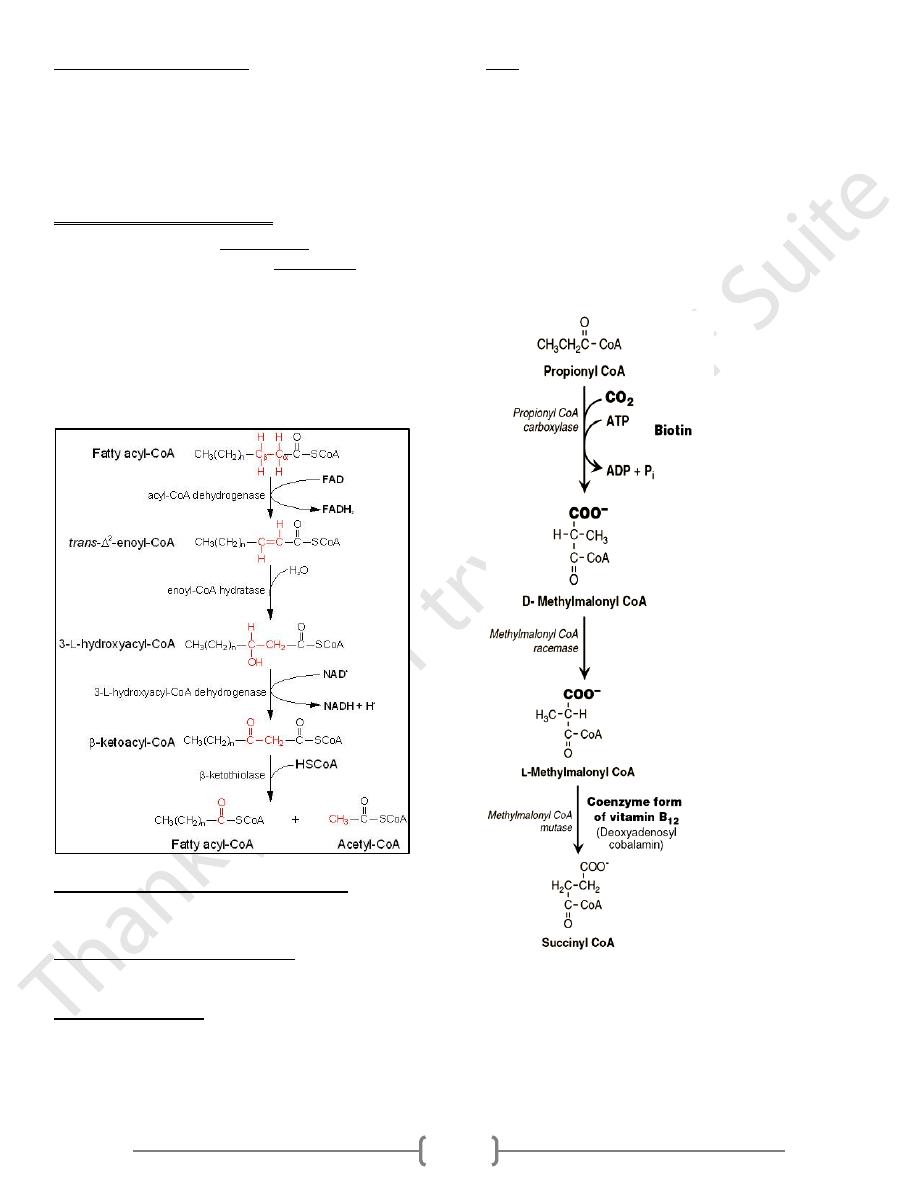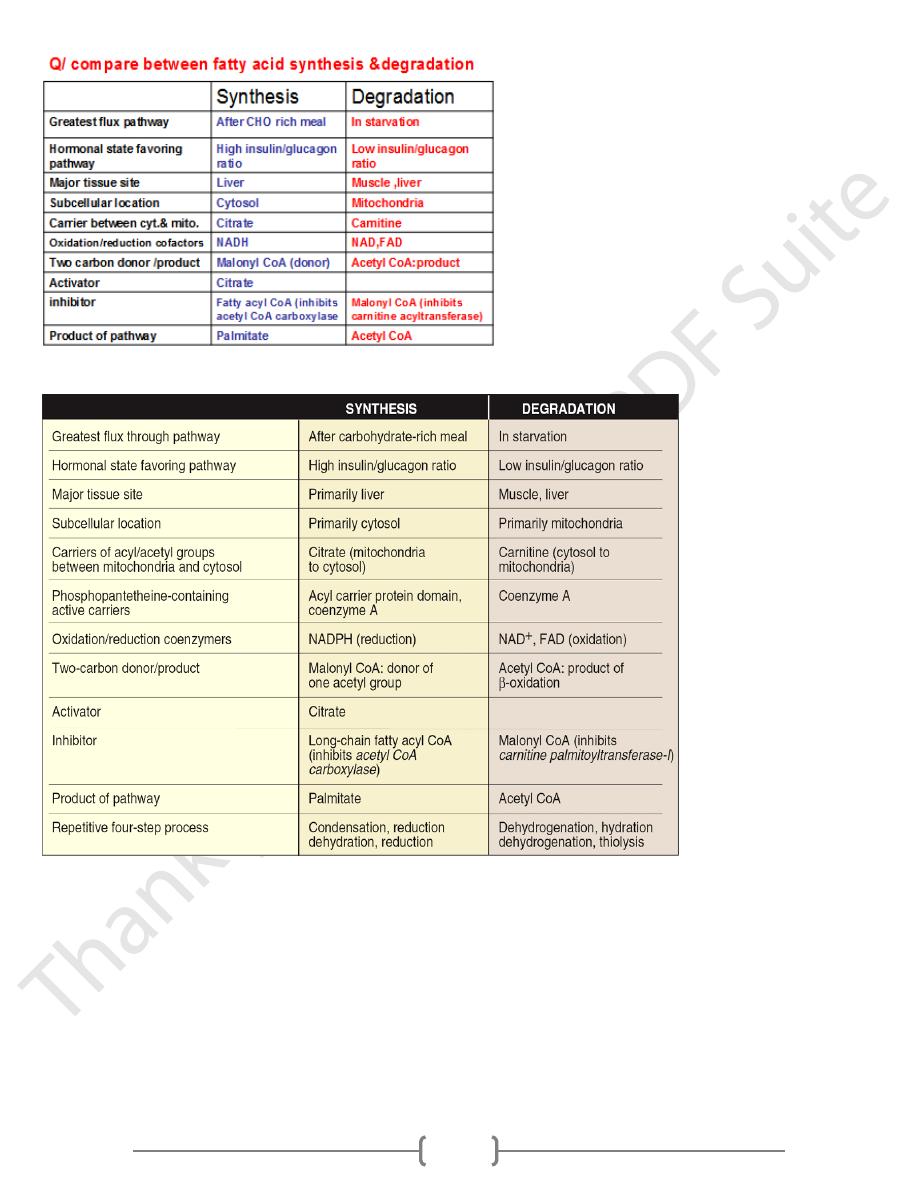
5
Lec. 3 Fatty acids oxidation
The process involves two steps:
1
st
- Release of fatty acids from TAG:
• The mobilization of stored fat
requires the release of fatty
acids & glycerol from their
TAG storage form.
• Control of Insulin, Glucagon,
TSH, Epinephrine
• Activation of HS lipase:
cAMP is produced in the
adipocyte when several
hormones, binds to receptors on
the cell membrane .
HS L activated by
phosphorylation with cyclic
AMP-dependant protein kinase.
1) Fate of glycerol:
Glycerol released cannot be
metabolized by adipocytes
because: they lack glycerol kinase; so that, glycerol is
transported to the liver, which phosphorylate it ,lead to
formation of glycerol phosphate which can be used to form
triacylglycerol or can be converted to dihydroxy acetone
phosphate (DHAP).
2) Fate of fatty acid:
• The free (unesterified) fatty acids move through the cell
membrane of the adipocyte & immediately bind albumin,
which carries them to the tissues where the fatty acid are
oxidized for energy (β-oxidation).
• The brain & other nervous tissue, erythrocytes, & the
adrenal medulla cannot use plasma free fatty acids for fuel,
regardless of the blood levels of fatty acid .
2
nd
- β-oxidation of fatty acids
In oxidation of fatty acids, two carbon fragments are
successively removed from the carboxyl end of the fatty acyl
CoA, producing acetyl CoA.
1) Stage 1- Transport of fatty acids into the mitochondria:
• After the fatty acids taken up by a cell, it is converted to the
CoA derivative by fatty acyl CoA synthetase (thiokinase) in
the cytosol, ( 2ATP is consumed in the formation of the thio-
ester bond in acyl CoA).
• Transport of FAs into the mitochondria
FAs shorter than 12 C. can cross the inner mito. membrane
without the aid of carnitine palmitoyl transferase system
CPT.
[Note: medium-chain FAs oxidation is not dependent on
CPT-I, so that it is not subject to inhibition by malonyl
CoA.]
Long-chain FFA will not penetrate the inner membrane of
mitochondria.
• Therefore, a carrier (carnitine) in mitochondrial membrane,
transports the acyl gp from the cytosol into the mitochondrial
matrix by process called the carnitine shuttle
• Carnitine shuttle.
1
st
step: acyl gp is transferred from the cytosolic coenzyme A
to carnitine by the action of carnitine acyltransferase I,
located on the outer surface of the inner mitochondrial
membrane.
2
nd
step : acylcarnitine group is transported to mitochondrial
matrix across the inner mitochondrial membrane by the action
of carnitine acyltransferase II located on the inner surface
of the inner mitochondrial membrane, where it is transferred
to another molecule of coenzyme A.

6
Inhibitor of the carnitine shuttle: Malonyl CoA:
o Inhibits carnitine acyltransferase I, thus inhibiting the
entry of acyl groups into the mitochondrial matrix.
o Therefore ,when fatty acid synthesis occurring in the cytosol
by presence of Malonyl CoA (the building block of fatty
acid ), the newly synthesized fatty acid chains cannot be
transferred into the mitochondria & degraded .
2) Stage 2- Reactions of β-oxidation:
It consists of a sequence of four reactions that result in the
shortening of the fatty acid chain by two carbons.
The steps include:
• Oxidation that produces FADH2.
• Hydration
• Oxidation that produces NADH.
• Thiolytic cleavage :
1-Releases a molecule of acetyl CoA (irreversible),
2-The final thiolytic cleavage produces two acetyl groups.
Energy yield from fatty acid oxidation
• The β-oxidation of 1 molecule of palmitoyl CoA to CO
2
&
H
2
O yields the following number of ATPs:
From Palmitoyl CoA to 8 acetyl CoA:
7 NADH , each one provide 3 ATP when oxidized = 21
7 FADH2 , each one provide 2 ATP when oxidized=14
From the 8 acetyl CoA:
Acetyl CoA provides 12 ATP (when converted to CO2& H2O
by the TCA cycle) ; 8 ×12=96
Total energy yield from one molecule of palmitoyl CoA
= 21 +14+ 96 =131
• Note:
When starting with FA palmitate, the ATP required for the
production of the palmitoyl CoA must be consider (two high
energy bond are broken )owing to the thiokinase reaction so
that the total energy yield is only 129 ATP.
The oxidation of unsaturated fatty acids provides less energy
than that of the saturated fatty acids because they are less
highly reduced, & therefore fewer reducing equivalents can be
produced from these structures).
Oxidation of FA with an odd number of carbons:
Same to the β- oxidation of even number of carbon no., until
the final three carbon reached (propionyl CoA) which is
metabolized by 2- step pathway:

7
